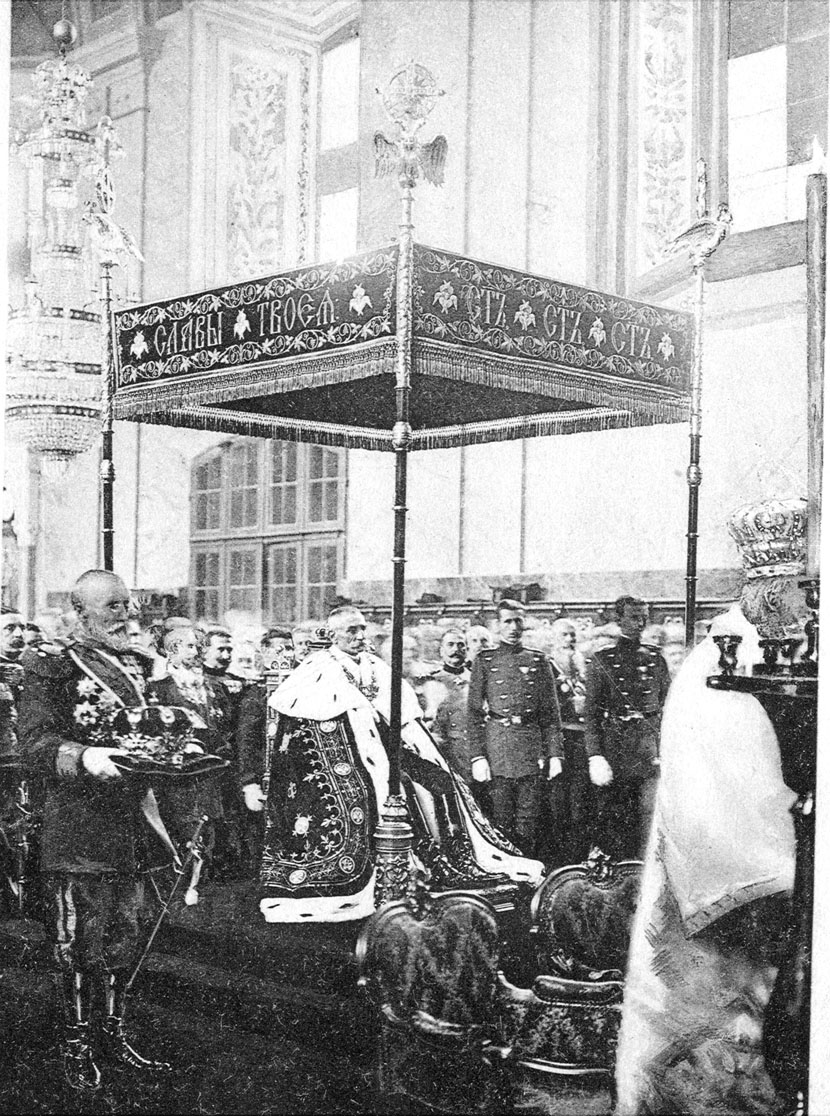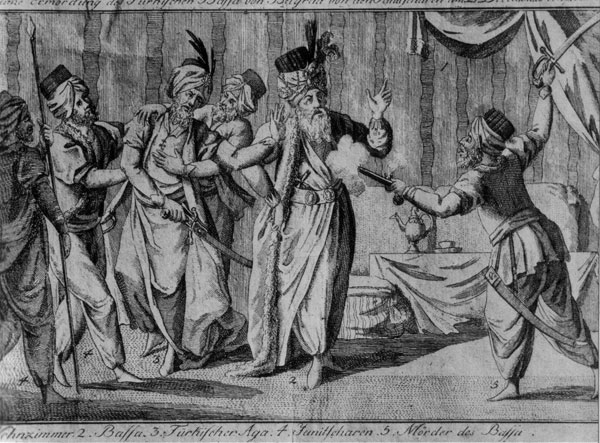|
St. Michael's Cathedral, Belgrade
The Cathedral Church of St. Michael the Archangel ( sr-Cyrl, Саборна Црква Св. Архангела Михаила, Saborna Crkva Sv. Arhangela Mihaila) is a Serbian Orthodox cathedral church in the centre of Belgrade, Serbia, situated in the old part of the city, at the intersection of Kralja Petra and Kneza Sime Markovića streets. It was built between 1837 and 1840, on the location of an older church also dedicated to Archangel Michael. It is one of the most important places of worship in the country. It is commonly known as just Saborna crkva (The cathedral) among the city residents. It was proclaimed as a Cultural Monument of Exceptional Importance in 1979. The cathedral church is one of the few preserved monuments of Belgrade from the first half of the 19th century. During the times when new social and political structures were slowly emerging, the cathedral church became a central support in the independence fight from Turkish centralism to the final freedom fr ... [...More Info...] [...Related Items...] OR: [Wikipedia] [Google] [Baidu] |
Belgrade
Belgrade ( , ;, ; Names of European cities in different languages: B, names in other languages) is the Capital city, capital and List of cities in Serbia, largest city in Serbia. It is located at the confluence of the Sava and Danube rivers and the crossroads of the Pannonian Basin, Pannonian Plain and the Balkan Peninsula. Nearly 1,166,763 million people live within the administrative limits of the City of Belgrade. It is the third largest of all List of cities and towns on Danube river, cities on the Danube river. Belgrade is one of the List of oldest continuously inhabited cities, oldest continuously inhabited cities in Europe and the world. One of the most important prehistoric cultures of Europe, the Vinča culture, evolved within the Belgrade area in the 6th millennium BC. In antiquity, Thracians, Thraco-Dacians inhabited the region and, after 279 BC, Celts settled the city, naming it ''Singidunum, Singidūn''. It was Roman Serbia, conquered by the Romans under the reign ... [...More Info...] [...Related Items...] OR: [Wikipedia] [Google] [Baidu] |
Cultural Monument Of Exceptional Importance
Immovable Cultural Heritage of Exceptional Importance ( sr, Непокретна културна добра од изузетног значаја/) are those objects of Immovable cultural heritage that enjoy the highest level of state protection in the Republic of Serbia. Immovable Cultural Heritage is classified as being of Exceptional Importance upon decision by the National Assembly of Serbia. They are inscribed in the ''Central Register of Immovable cultural property'' maintained by the Institute for the Protection of Cultural Monuments of Serbia. Objects of Immovable cultural heritage have to fulfill one or more of those criteria defined in the ''Law on Cultural Heritage'' of 1994 in order to be categorized as being "of exceptional importance": # exceptional importance for social, historical or cultural development of the people, or for the development of its natural environment; # evidence of important historic events or persons and their work; # unique (rare) example of huma ... [...More Info...] [...Related Items...] OR: [Wikipedia] [Google] [Baidu] |
Petar Čukić
Petar ( sr, Петар, bg, Петър) is a South Slavic masculine given name, their variant of the Biblical name Petros cognate to Peter. Derivative forms include Pero, Pejo, Pera, Perica, Petrica, Periša. Feminine equivalent is Petra. People mononymously known as Petar include: * Petar of Serbia ( – 917), early Prince of the Serbia * Petar of Duklja (), early archont in Dioclea * Petar Krešimir (died 1074/1075), King of Croatia and Dalmatia * * Notable people with the name are numerous: * See also * Sveti Petar (other) * Petrić * Petričević Petričević ( sr-cyr, Петричевић) is a Serbo-Croatian surname, a patronymic derived from ''Petrič'', a diminutive of Petar. It may refer to: *Bogdan Petričević (born 1989), Montenegrin handball player *Luka Petričević (born 1992), M ... References {{reflist Serbian masculine given names Bulgarian masculine given names Croatian masculine given names ... [...More Info...] [...Related Items...] OR: [Wikipedia] [Google] [Baidu] |
Miloš Obrenović
Miloš, Milos, Miłosz or spelling variations thereof is a masculine given name and a surname. It may refer to: Given name Sportsmen * Miłosz Bernatajtys, Polish rower * Miloš Bogunović, Serbian footballer * Miloš Budaković, Serbian footballer * Miloš Ćuk, Serbian water polo player, Olympic champion * Miloš Dimitrijević, Serbian footballer * Miloš Holuša, Czech race walker * Miloš Jojić, Serbian footballer * Miloš Korolija, Serbian water polo player * Miloš Krasić, Serbian footballer * Miloš Marić, Serbian footballer * Miloš Milošević, Croatian swimmer * Miloš Milutinović, Serbian footballer and manager * Miloš Nikić, Serbian volleyball player * Miloš Ninković, Serbian footballer * Miloš Pavlović (racing driver), Serbian racing driver * Milos Raonic, Montenegrin-born Canadian tennis player * Miloš Stanojević (rower), Serbian rower * Miloš Šestić, Serbian footballer * Miloš Teodosić, Serbian basketball player * Miloš Terzić, Serbian vo ... [...More Info...] [...Related Items...] OR: [Wikipedia] [Google] [Baidu] |
Hatisheriff
Hatt-i humayun ( ota, خط همايون , plural , ), also known as hatt-i sharif ( , plural , ), was the diplomatics term for a document or handwritten note of an official nature composed by an Ottoman sultan. These notes were commonly written by the sultan personally, although they could also be transcribed by a palace scribe. They were written usually in response to, and directly on, a document submitted to the sultan by the grand vizier or another officer of the Ottoman government. Thus, they could be approvals or denials of a letter of petition, acknowledgements of a report, grants of permission for a request, an annotation to a decree, or other government documents. Hatt-i humayuns could also be composed from scratch, rather than as a response to an existing document. After the Tanzimat era (1839–1876), aimed at modernizing the Ottoman Empire, hatt-i humayuns of the routine kind were supplanted by the practice of irade-i seniyye ( ota, اراده سنیه ; french: iradé ... [...More Info...] [...Related Items...] OR: [Wikipedia] [Google] [Baidu] |
Second Serbian Uprising
The Second Serbian Uprising ( sr, Други српски устанак / ''Drugi srpski ustanak'', tr, İkinci Sırp Ayaklanması) was the second phase of the Serbian Revolution against the Ottoman Empire, which erupted shortly after the re-annexation of the country to the Ottoman Empire in 1813. The occupation was enforced following the defeat of the First Serbian Uprising (1804–1813), during which Serbia existed as a ''de facto'' independent state for over a decade. The second revolution ultimately resulted in Serbian semi-independence from the Ottoman Empire. The Principality of Serbia was established, governed by its own parliament, constitution and royal dynasty. ''De jure'' independence, however, was attained in 1878, following the decisions of the Congress of Berlin. Background The First Serbian Uprising liberated the country for a significant time (1804–1813) from the Ottoman Empire; for the first time in three centuries, Serbs governed themselves without the su ... [...More Info...] [...Related Items...] OR: [Wikipedia] [Google] [Baidu] |
First Serbian Uprising
The First Serbian Uprising ( sr, Prvi srpski ustanak, italics=yes, sr-Cyrl, Први српски устанак; tr, Birinci Sırp Ayaklanması) was an uprising of Serbs in the Sanjak of Smederevo against the Ottoman Empire from 14 February 1804 to 7 October 1813. Initially a local revolt against Dahije, renegade janissaries who had seized power through a coup, it evolved into a revolution, war for independence (the Serbian Revolution) after more than three centuries of Ottoman rule and short-lasting Austrian occupations. The janissary commanders murdered the Ottoman Vizier in 1801 and occupied the sanjak, ruling it independently from the Ottoman Sultan. Tyranny ensued; the janissaries suspended the rights granted to Serbs by the Sultan earlier, increased taxes, and imposed forced labor, among other things. In 1804 the janissaries feared that the Sultan would use the Serbs against them, so they Slaughter of the Knezes, murdered many Serbian chiefs. Enraged, an assembly chose Ka ... [...More Info...] [...Related Items...] OR: [Wikipedia] [Google] [Baidu] |
Treaty Of Belgrade
The Treaty of Belgrade, also known as the Belgrade Peace, was the peace treaty signed on September 18, 1739 in Belgrade, Habsburg Kingdom of Serbia (today Serbia), by the Ottoman Empire on one side and the Habsburg monarchy on the other, that ended the Austro–Turkish War (1737–39). Background Treaty This treaty ended the hostilities of the five-year Austro-Russian–Turkish War (1735–39), in which the Habsburgs joined Imperial Russia in its fight against the Ottomans. Austria was defeated by the Turks at Grocka and signed a separate treaty in Belgrade with the Ottoman Empire on August 21, probably being alarmed at the prospect of Russian military success. With the Treaty of Belgrade, the Habsburgs ceded the Kingdom of Serbia with Belgrade, the southern part of the Banat of Temeswar and northern Bosnia to the Ottomans, and the Banat of Craiova (Oltenia), gained by the Treaty of Passarowitz in 1718, to Wallachia (an Ottoman subject), and set the demarcation line to ... [...More Info...] [...Related Items...] OR: [Wikipedia] [Google] [Baidu] |
Peter The Great
Peter I ( – ), most commonly known as Peter the Great,) or Pyotr Alekséyevich ( rus, Пётр Алексе́евич, p=ˈpʲɵtr ɐlʲɪˈksʲejɪvʲɪtɕ, , group=pron was a Russian monarch who ruled the Tsardom of Russia from to 1721 and subsequently the Russian Empire until his death in 1725, jointly ruling with his elder half-brother, Ivan V until 1696. He is primarily credited with the modernisation of the country, transforming it into a European power. Through a number of successful wars, he captured ports at Azov and the Baltic Sea, laying the groundwork for the Imperial Russian Navy, ending uncontested Swedish supremacy in the Baltic and beginning the Tsardom's expansion into a much larger empire that became a major European power. He led a cultural revolution that replaced some of the traditionalist and medieval social and political systems with ones that were modern, scientific, Westernised and based on the Enlightenment. Peter's reforms had a lasting ... [...More Info...] [...Related Items...] OR: [Wikipedia] [Google] [Baidu] |
Mojsije Petrović
Mojsije Petrović (Serbian Cyrillic: Мојсије Петровић; Belgrade, Ottoman Empire, 1677 – Belgrade, Habsburg monarchy, 27 July 1730) was the first Metropolitan of the unified Metropolitanate of Belgrade and Karlovci, from 1726 to 1730. As such, he exercised great influence among the Serbian and Romanian Orthodox faithful in the Habsburg Monarchy. His close friendships with Prince Eugene of Savoy and Count Claude Florimond de Mercy contributed substantially to Charles VI's victories at the Battle of Petrovaradin in August 1716, Belgrade (1717), and the conquest of the Banat of Temesvár over the Ottoman Turks. The opportunity to elect a prelate for dual function emerged in 1725 after the death of Metropolitan Vićentije Popović of Karlovci. Following his funeral, the high clergy convened in the Krušedol Monastery and wrote an official demand to the Emperor to summon an Assembly in order to elect a new Metropolitan of Karlovci. The plea was accepted, and the Ass ... [...More Info...] [...Related Items...] OR: [Wikipedia] [Google] [Baidu] |
Coronation In Saborna Crkva
A coronation is the act of placement or bestowal of a crown upon a monarch's head. The term also generally refers not only to the physical crowning but to the whole ceremony wherein the act of crowning occurs, along with the presentation of other items of regalia, marking the formal investiture of a monarch with regal power. Aside from the crowning, a coronation ceremony may comprise many other rituals such as the taking of special vows by the monarch, the investing and presentation of regalia to the monarch, and acts of homage by the new ruler's subjects and the performance of other ritual deeds of special significance to the particular nation. Western-style coronations have often included anointing the monarch with holy oil, or chrism as it is often called; the anointing ritual's religious significance follows examples found in the Bible. The monarch's consort may also be crowned, either simultaneously with the monarch or as a separate event. Once a vital ritual among the wo ... [...More Info...] [...Related Items...] OR: [Wikipedia] [Google] [Baidu] |

.jpg)




